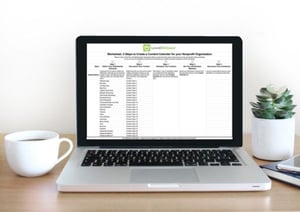LetsAllDoGood Blog

5 Steps to Create Your Nonprofit Content Calendar
So you’re going to create a content calendar. Congratulations!
A content calendar is a powerful reminder of where your nonprofit team’s attention and focus should be.
The Content Calendar Template we’ve created for you is based on a year, so that will be the foundation of our examples. You may decide to take a quarterly, bi-annual, or longer-term approach to content scheduling, and that’s great, too! Go with whatever aligns best with your nonprofit’s strategic objectives.
“Crawl, Walk, Run” is a methodology we love for starting new projects. As the name implies, you first master a basic version of a content calendar before trying to take on too much. With the basic version complete and functioning, you add on another layer, and begin to “walk” with your content scheduling. Finally, you’re ready to “run” and build out the calendar with some granularity. The run stage may be something your marketing/communications team takes on as part of its marketing plan or something your entire team owns.
The key is to determine what works for your nonprofit organization, and begin there. So… let's begin.
1. Don’t start with content. Start with distribution.
It seems counterintuitive, but the first step in creating a content calendar is not about content. Instead, it is critical to begin by identifying your distribution channels, or how you plan to deliver your content once it’s created.
It’s important to understand the distinction between content and distribution channels. An article about the importance of having a step counter for the upcoming walk-a-thon is the content, the blog where it is published is the distribution channel. A few more examples:
| Content | Distribution Channel |
| Statistics about how fundraising dollars are spent. | Social media |
| Deadlines for event registration. | Your newsletter |
| A profile of a client who benefits from your fundraising, | The email that shares the story |
Think through and document each of the distribution channels you have, or may have in the upcoming year, including:
- Your website:
- Website pages
- Microsite
- Landing pages
- Blog posts
- Social media platforms:
- Organic posts
- Boosted posts
- Paid social advertising
- Emails:
- Broadcast emails
- Electronic newsletters
- Partnered/chaperoned emails
- Smartphone communications:
- Text/SMS
- Push notifications
- Broadcasts:
- Webinars, live or prerecorded
- Podcasts, internal or external
- Videos
- Public relations:
- Press release
- Interviews
- Byline stories
- Printed Material:
- Flyer
- Brochure
- Postcard
- Other:
- Sponsored Content
2. Document your content—all of it.
A critical prerequisite for this step: Bring all key stakeholders from your organization to the table, including fundraising, volunteer coordination, workforce development, advocacy, marketing, public relations, and anyone else who may be creating or publishing content.
Start with the top-level content
Think big. What annual events or campaigns are the focus of your organization’s year?
Add in the next-level content
These may be smaller events, campaigns, or reports that you publish on behalf of those you serve.
Depending on the size of your organization, this may be as much as you want to document for your first content calendar. Top- and next-level content is a solid place for any organization to start.
Add the supporting content (your stories)
This is a task for those who are ready to “walk” with their organization’s content schedule
Supporting content is the stories we tell to build awareness and promote established top- and next-level content. For example, an annual food drive may build out supporting content that discusses where the food is going, the impact of the donations, a profile of someone who will benefit from the donations, and reasons why giving is so important.
Content Documenting Options
- Post-it notes on a large wall. Your nonprofit can have different color notes for top-, next- and supporting-level content, or maybe a specific color representing each of your departments. Having these notes easily visible and movable allows for a flexibile, agile approach to the process.
- A shared or projected spreadsheet. While personally, we prefer an analog content-documenting process, the end product is going to be digital, and some prefer to start there. If your team is remote, you must start there. If you choose to document electronically, prepare the document and test in advance how it will work for your team.
3. Schedule your content.
If you’re using post-it notes, put them in chronological order based on where you’re starting the content year. If you’re working digitally, you can copy your content items into a schedule.
Begin with your top-level content
The events, campaigns, or programs that are at the core of your nonprofit organization’s mission.
Next, lock in your date-sensitive content
Say you have content that aligns with Women’s History Month. You have to publish that content in March. Lock in anything on your content calendar that cannot be moved or is out of your control.
Add supporting content
For those who are going more granular with the content schedule, here is where you’ll add the supporting content you’ve identified.
An important consideration, you don’t have to schedule everything you document. In this process you might realize that March is just too busy to recognize #PeanutButterLoversDay on March 1 and decide to table it till next year. Or key dates and deadlines may not yet be available and you’ll have to add them later on.
4. Set your distribution methods.
With your distribution channels and content schedule decided on, it is time to determine which channels you are going to publish the content in and when. Note, this isn’t about creating a full production schedule for these projects. This is just about when your content will “drop” and “hit.”
A drop date is when you publish the content, and a hit date is when you expect the audience to receive it. And yes, with channels like email, these are often the same date, but when you’re talking about a printed piece, your printing and mailing time need to be factored in.
Also, be mindful that content can have more than one distribution channel (and date). You can publish an article in your blog, and perhaps also in a partnering magazine on the same or different date.
*Side note for our “runners”: We recommend you have a way to track the effectiveness of each of your channels in motivating your audiences to engage with your content. For example, if you have a profile of a client online, use different UTM codes when pointing to that content from organic social, the newsletter, and the push notification.
5. Document your content schedule and your omissions.
If you’ve been documenting the content digitally and working in a spreadsheet, you may already have what you need.
If you’ve been moving post-it notes around on a wall you now need to move from analog to digital, and a spreadsheet is the next logical step. There are a lot of templates you can download around the internet, and we have our own template that you may find helpful.
Documenting your omissions is just as important as documenting your inclusions! Without this step, you’ll find purposefully omitted content creeping back into your schedule and mucking up what is becoming a well-planned content strategy.
Include what you’re not covering, why you’re not covering it, and who will make the determination to revisit this decision.
If the content isn’t being scheduled because of missing critical information, determine who is going to own gathering that information and who will see that the content calendar is updated.
Now… Sit back and bask in the glow of your nonprofit organization’s content calendar!
But not for too long. When you get back from your victory lap, there are a few additional things you’ll want to consider as you wrap it up.
Partner, national, or local content
If you have any content publishing agreements with partner organizations, or perhaps with a national organization or local affiliate, be sure to document their content in step 2. Without those obligations included, you risk conflicts and overloading your already full calendar.
Look for opportunities as you’re scheduling your content
With everyone at the table, there may be projects brought up that not everyone was aware of and there may be natural adjacencies between them. Content from the promotion of a campaign, can also be used as part of another similar campaign at another point in the year.
Republish and repurpose content
If there are gaps in your content schedule and new content isn’t available, consider republishing previous content. It can be framed as part of a “throwback” or trip down memory lane.
Additionally, you can repurpose content from an interview, podcast, or video by turning it into a written story on your blog. Quotes can also be pulled into social media graphics or sidebars for other stories.
Be mindful of current events
Don’t let your proactive planning turn into a PR disaster. As you execute your content schedule, be mindful of current events that may have changed the landscape since you created the original plan. A post in one light, can look very different in another.
Be flexible
Content plans need to be revisited and revised frequently as situations change, internally, and externally.
Be especially mindful when internal-only factors are driving your schedule. If that schedule is now unrealistic, there is no harm in adjusting as you go.
Don’t let perfection get in the way of progress
Remember, a productive content schedule is going to be a perpetual work in progress, a living document that, like wine, gets better with age, but can still be immediately effective.
Interesting in building your own content calendar?
Download our Free Nonprofit Content Calendar Worksheet & Template!

